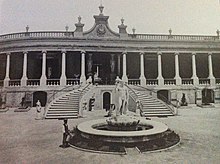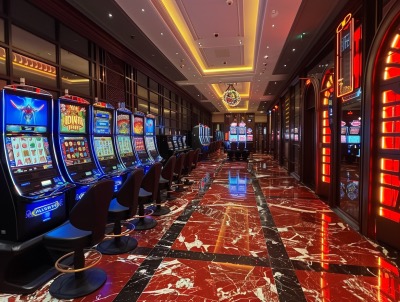Dragonara Casino Restaurant Malta
- The Westin Dragonara Resort
- Westin Dragonara Malta
- Dragonara Casino Restaurant Malta Menu
- Portomaso Casino Malta
- Dragonara Casino Restaurant Malta Hotel
| Dragonara Palace | |
|---|---|
View of the Dragonara Palace | |
| Alternative names | Palazzo Dragonara Villa Dragonara Dragonara Casino |
| General information | |
| Status | Intact |
| Type | Palace (now casino) |
| Architectural style | Neoclassical |
| Location | St. Julian's, Malta |
| Coordinates | 35°55′35″N14°29′40.9″E / 35.92639°N 14.494694°E |
| Named for | Dragonara Point |
| Completed | 1870 |
| Technical details | |
| Material | Limestone |
| Website | |
| www.dragonaracasino.com | |
Dragonara Palace (Maltese: Il-Palazz tad-Dragunara), also known as Palazzo Dragonara[1] or Villa Dragonara,[2] is a palace in St. Julian's, Malta. It was built in 1870 as a summer residence for the Scicluna family, and it is now a casino called Dragonara Casino.
The Westin Dragonara Resort
Etymology[edit]
Restaurants near Dragonara Casino, Saint Julian's on Tripadvisor: Find traveler reviews and candid photos of dining near Dragonara Casino in Saint Julian's, Malta. Quadro, the flagship restaurant of The Westin Dragonara Resort, offers some of the best dining on the island. Open for dinner, this contemporary brasserie specializes in simple, homemade food with a focus on select fresh, local produce with a light and healthy twist. Dragonara Casino Restaurant Malta, casino de mendoza calle san martin, 1980 slot machine for sale bally, atlantic city poker sites.
The palace is named after Dragonara Point, the peninsula on which it was built. According to local legends, a dragon lived in caves near the peninsula, but the roaring which was heard was probably the sound of the waves hitting the rocks or the howling of the wind. It is believed that the rumours of the dragon were spread by smugglers to discourage people from going to the area.A more valid theory is that its name has been given because of the camp of Turgut Reis (known as Dragut) was in this area before the Great Siege battle on 1565, Dragut few years before conquested Gozo and moved a contingency in the area. Dragut died about 3 km away from this point, in nautical charters it is still known as Dragut Point but today is commonly known as Tignè Point because of the freemason who occupied the area just after the siege.[3][4]
Restaurants near Dragonara Casino, Saint Julian's on Tripadvisor: Find traveller reviews and candid photos of dining near Dragonara Casino in Saint Julian's, Malta. Entrance to the Boathouse Lounge is through Palio's Restaurant, which is located on the road leading to the Dragonara Casino. Free parking is available for patrons at the hotel's car park. A limited number of dining tables are available, therefore booking in advance is recommended.
History[edit]
The Dragonara Palace was built in 1870 on Dragonara Point, which had been previously occupied by Ta' Għemmuna Battery.[5] The peninsula where it is built was originally known as Għemmuna Point.[6]

The palace served as the summer residence of Emanuele Scicluna, a banker who became a marquis in 1875.[3]
During World War I, it was temporarily used as an officers' hospital.[7][8][9] Later on, the Scicluna family hosted over 100 refugees in the palace during World War II.[10]
The palace opened as a casino on 15 July 1964, at a time when nearby Paceville began its transition from a mainly agricultural area to a tourist hub.[11] The Dragonara Casino was the first casino in Malta, and this was a major step in establishing Malta as a tourist destination.[12] In the 1990s, The Westin Dragonara hotel was built on part of the palace's gardens.[13]
Westin Dragonara Malta
The casino was privatized in 1999, and the company Dragonara Casino Ltd was set up to run the business for 10 years.[14] The palace was restored in 2008.[15] Two years later, the casino was taken over by Dragonara Gaming Ltd, who have spent over €15 million in renovating the building.[12] It receives about 350,000 patrons annually, making it the most popular casino in Malta.[16]
The palace is listed on the National Inventory of the Cultural Property of the Maltese Islands.[17]
Architecture[edit]


Dragonara Palace is built in neoclassical architecture, and its colonnades are inspired by those of Villa Portelli and Palazzo Capua.[18] The design of the Dragonara Palace later inspired the colonnades of Palazzo Pescatore, which was built in St. Paul's Bay in the late 19th century.[1]
The palace's architect is not known, but it is sometimes attributed to Giuseppe Bonavia.[19]
Palace[edit]

The palace originally consisted of a colonnaded villa with a central courtyard.[3] The Scicluna family leased the property in 1964 to the Kursaal Company Limited when the courtyard was roofed becoming the casino's gaming rooms and the Slots Palace was built at the back, which were designed by Dom Mintoff, an architect who eventually became Prime Minister of Malta. At this stage the Sheraton Hotel was built on the ground of the palace's gardens[20] that was eventually replaced by The Westin Dragonara.
Gardens[edit]

When the palace was originally built, it was surrounded by extensive gardens. Part of these were destroyed to make way for The Westin Dragonara hotel and the casino's parking lot.[13] The palace's Sunken Garden, which contains a number of fountains and olive trees, is now located within the grounds of The Westin Dragonara.[21]
Dragonara Casino Restaurant Malta Menu
Art[edit]
Main entrance[edit]
The main entrance into the palace's gardens consists of an arch with the inscription Deus Nobis Haec Otia Fecit, meaning 'God made these leisures for us'.[3] It is designated as a Grade 1 property by the Malta Environment and Planning Authority.[22]
Statue of Neptune[edit]
A fountain containing a statue of Neptune was located at the entrance of the palace, just after the path leading from the gardens. The statue was built in the 19th century, but it is inspired by an earlier statue of Neptune which is now found in the courtyard of the Grandmaster's Palace in Valletta. The fountain and statue are now located inside the palace for their preservation.[23]
Statue of Marquis Scicluna[edit]
Since the statue of Neptune was relocated to the palace, a life-sized statue of Marquis Emanuele Scicluna has been located in its place. The statue was designed by the Italian sculptor Giulio Moschetti,[24] and it was restored in 2014.[25]
Egyptian caryatids[edit]
Portomaso Casino Malta
Two Egyptian-stylecaryatids are located near the palace's doorway, supporting the building.[24]
Frescoes[edit]
Some rooms of the palace contain frescoes painted by Vincenzo Maria Cremona. The fresco in the Yellow Room shows military and floral paraphernalia, as well as a bird holding a garland of roses. The ceiling panels of the Green Room has frescoes showing a personification of industry.[26]
References[edit]
- ^ ab'One World - Protecting the most significant buildings, monuments and features of the Maltese islands (05)'. Times of Malta. 9 June 2009. Retrieved 2 October 2015.
- ^Blasi, Abigail (2013). Malta & Gozo. Lonely Planet. p. 133. ISBN9781743213810.
- ^ abcdGaul, Simon (2007). Malta, Gozo and Comino. New Holland Publishers. p. 160. ISBN9781860113659.
- ^Morana, Martin (2011). Bejn Kliem u Storja (in Maltese). Malta: Books Distributors Limited. ISBN978-99957-0137-6. Archived from the original on 5 October 2016.
- ^Spiteri, Stephen C. (May 2008). 'Maltese 'siege' batteries of the blockade 1798–1800'(PDF). Arx – Online Journal of Military Architecture and Fortification (6): 43. Retrieved 2 October 2015.
- ^Borg-Bartolo, R. (1978). 'Chark el Hamiem'. Heritage: An Encyclopedia of Maltese Culture and Civilization (14): 270–271.
- ^Anzac experience in Malta, p. 6.
- ^Nicklaus Thomas-Symonds (2012), 'Attlee: A Life in Politics', I.B.Tauris Publishers,ISBN9780857730749.
- ^Tenison, E. M. (1922). A Short History of the Order of Saint John of Jerusalem from its foundation in A.D. 1014 to the End of the Great War A.D. 1914-18 (2 ed.). London: Society of SS. Peter and Paul. p. 98. Archived from the original on 24 September 2015. Retrieved 2 October 2015.
- ^Manduca, John (4 November 2008). 'Achievement, tragedy and failure'. Times of Malta. Retrieved 2 October 2015.
- ^Aguis (2014), pp. 65-71.
- ^ ab'Dragonara Casino celebrates 50 years, announces extension and restoration project'. Malta Today. 16 July 2014. Retrieved 2 October 2015.
- ^ abRix, Juliet (2013). Malta and Gozo (2 ed.). Bradt Travel Guides. p. 177. ISBN9781841624525.
- ^Séminaire Omt Sur Le Tourismeet Le Transport Aérien. World Tourism Organization. 2001. ISBN9789284403691.
- ^'Dragonara Casino restoration project'. Times of Malta. 5 February 2008. Retrieved 2 October 2015.
- ^'Dragonara Palace'. Dragonara Casino. Archived from the original on 21 February 2015. Retrieved 2 October 2015.
- ^'Dragonara Palace'(PDF). National Inventory of the Cultural Property of the Maltese Islands. 28 December 2012. Retrieved 17 October 2015.
- ^'Architecture in Malta under the British'. culturemalta.org. Retrieved 2 October 2015.
- ^Agius 2014, p. 17.
- ^Aguis (2014), p. 71.
- ^'The Sunken Garden'. The Westin Dragonara. Retrieved 2 October 2015.
- ^'Development Planning Act, 1992 Section 46 Scheduling of Property'. MEPA. Archived from the original on 4 March 2016.
- ^Agius 2014, pp. 16–19.
- ^ abAgius 2014, p. 19.
- ^'Dragonara Casino celebrates its 50th anniversary in style'. Times of Malta. 20 July 2014. Retrieved 2 October 2015.
- ^Agius 2014, pp. 44–49.
Sources[edit]
- Agius, Frederica (2014). The Dragonara Palace. A Historic Perspective. Dragonara Gaming Limited. ISBN9789995707187.
Dragonara Casino Restaurant Malta Hotel
External links[edit]
| Wikimedia Commons has media related to Dragonara Palace. |